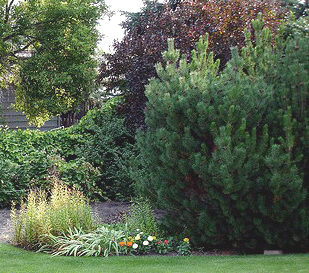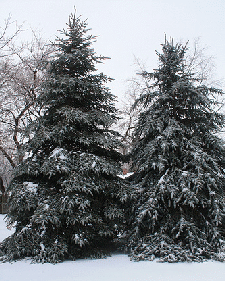Evergreens for Midwestern Landscapes and Gardens
Year round interest in your landscape is easily achieved with evergreen trees and shrubs.
Narrowleaf evergreen (conifers) trees and shrubs are among the most expensive plants used in the landscape, and many of them are not easily moved. So it is important to carefully select and place your evergreens. Since evergreens are often used as foundation or entry plantings, be sure you know the mature size of your selection so your evergreen does not crowd the foundation or block windows. Allow plenty of space between plants and structures for them to grow to full size and still allow passing space for maintenance. See the foundation planting article for guidance. As a general guideline for growth rates: “miniatures” grow less than 3 inches per year; “dwarfs” grow 3-6 inches per year; “intermediates” grow 6-12” per year; and Large grow more that 12 inches per year. But growth rates can vary dramatically based on the species and conditions.
In the north and midwest, hardiness of evergreens is critical, but there is much more to consider than just cold hardy. Since evergreens do not go dormant in winter, their branches and needles are susceptible to winter burn, sun scald and tip kill. These injuries are caused by drying winds, scalding sun reflecting off snow and low water reserves in the plant and soil. Preventive measures can help, read about protecting your evergreens from winter. Watering evergreens deeply through summer and as far into winter as possible is one of the best ways to minimize winter injury. Evergreens that receive warm afternoon sun in winter warms quickly, then quickly assaulted by freezing temperatures when the sun goes down. The best prevention is to try to select varieties that resist damage from winter.
Near roadways, evergreens can be severely damaged by salt spray from snow plows. Since the damage usually cannot be prevented, and often does not heal, the best thing is to plant evergreens a great distance from roadways that are frequently salted, de-iced, and plowed. Plows can send chemical spray as much as 30 to 60 feet into your property.
When used at corners or large bare spaces of your home, in open spaces, or near the perimeter of your property, tall dense evergreens can make a big impact in many ways. Evergreens can add height, color, and texture in all seasons. A grouping of evergreens can create a privacy screen, a noise barrier, or a windbreak to block cold north winds. Evergreens planted on the north side of a drive or patio can create a warm and sunny microclimate in winter by trapping and reflecting sunlight. Smaller shrubs used as foundation plantings can add insulation when properly planted. But poorly placed evergreens can block windows from sunlight making your home dark and dreary, or making a patio cool and gloomy. Deciduous trees that drop their leaves for winter might be a better choice to filter hot summer sun since they will allow sunshine through their bare branches in winter.
Although homeowners and gardeners in the north tend to get bored with the same old arborvitae and yew, they are widely used because of their hardiness and resistance to winter injury. Healthy and boring is a lot better than interesting but half dead. With that said, DO consider selections from the many, many varieties of evergreens. False cypress for example, has proven to be cold hardy and resistant to winter injury in zone 4. The threadleaf branches of lovely golden green are bright and elegant. Many of the junipers are hardy to zone 4 as well as zone 3, and offer a variety of shapes, size, texture and color.
Evergreens offer an array of size and shape for any design need. Globe, tall conical, and pyramid shapes are commonly seen. But many varieties are also available that are spreading with graceful arching branches, spreading with upright branches, low spreading or creeping. And colors range from bright golden yellow or golden green, deep or bright green, and blue green to gray green. Some produce acorns, some produce berries. Some are dense and prickly, some soft and graceful. And there are a lot of topiary evergreens available. Some requiring meticulous pruning to maintain, and some requiring no pruning at all, like the grafted blue spruce or creeping junipers. So don’t let evergreens bore you! Try something new! Information about specific evergreen plants on the following pages are specifically not grouped by genus. Perhaps then you may scroll past something different that catches your eye!
Do your homework before selecting an evergreen. Most evergreens like quite a bit of sun, they all like plenty of water, and good soil with a dose of fertilizer in spring. Some will want a little pruning or shearing, some don’t need any at all. But each will have quite unique needs, so choose the best evergreen for your planting site and maintenance preferences.

